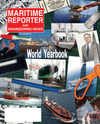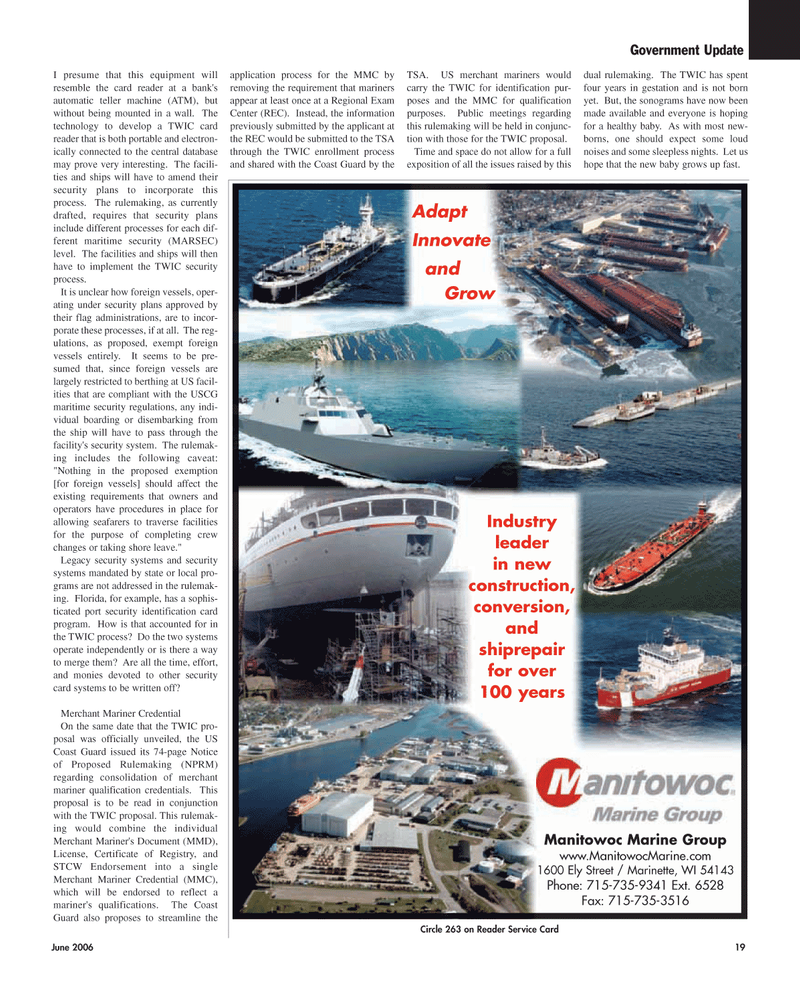
Page 19: of Maritime Reporter Magazine (June 2006)
Annual World Yearbook
Read this page in Pdf, Flash or Html5 edition of June 2006 Maritime Reporter Magazine
June 2006 19
I presume that this equipment will resemble the card reader at a bank's automatic teller machine (ATM), but without being mounted in a wall. The technology to develop a TWIC card reader that is both portable and electron- ically connected to the central database may prove very interesting. The facili- ties and ships will have to amend their security plans to incorporate this process. The rulemaking, as currently drafted, requires that security plans include different processes for each dif- ferent maritime security (MARSEC) level. The facilities and ships will then have to implement the TWIC security process.
It is unclear how foreign vessels, oper- ating under security plans approved by their flag administrations, are to incor- porate these processes, if at all. The reg- ulations, as proposed, exempt foreign vessels entirely. It seems to be pre- sumed that, since foreign vessels are largely restricted to berthing at US facil- ities that are compliant with the USCG maritime security regulations, any indi- vidual boarding or disembarking from the ship will have to pass through the facility's security system. The rulemak- ing includes the following caveat: "Nothing in the proposed exemption [for foreign vessels] should affect the existing requirements that owners and operators have procedures in place for allowing seafarers to traverse facilities for the purpose of completing crew changes or taking shore leave."
Legacy security systems and security systems mandated by state or local pro- grams are not addressed in the rulemak- ing. Florida, for example, has a sophis- ticated port security identification card program. How is that accounted for in the TWIC process? Do the two systems operate independently or is there a way to merge them? Are all the time, effort, and monies devoted to other security card systems to be written off?
Merchant Mariner Credential
On the same date that the TWIC pro- posal was officially unveiled, the US
Coast Guard issued its 74-page Notice of Proposed Rulemaking (NPRM) regarding consolidation of merchant mariner qualification credentials. This proposal is to be read in conjunction with the TWIC proposal. This rulemak- ing would combine the individual
Merchant Mariner's Document (MMD),
License, Certificate of Registry, and
STCW Endorsement into a single
Merchant Mariner Credential (MMC), which will be endorsed to reflect a mariner's qualifications. The Coast
Guard also proposes to streamline the application process for the MMC by removing the requirement that mariners appear at least once at a Regional Exam
Center (REC). Instead, the information previously submitted by the applicant at the REC would be submitted to the TSA through the TWIC enrollment process and shared with the Coast Guard by the
TSA. US merchant mariners would carry the TWIC for identification pur- poses and the MMC for qualification purposes. Public meetings regarding this rulemaking will be held in conjunc- tion with those for the TWIC proposal.
Time and space do not allow for a full exposition of all the issues raised by this dual rulemaking. The TWIC has spent four years in gestation and is not born yet. But, the sonograms have now been made available and everyone is hoping for a healthy baby. As with most new- borns, one should expect some loud noises and some sleepless nights. Let us hope that the new baby grows up fast.
Manitowoc Marine Group www.ManitowocMarine.com 1600 Ely Street / Marinette, WI 54143
Phone: 715-735-9341 Ext. 6528
Fax: 715-735-3516
Industry leader in new construction, conversion, and shiprepair for over 100 years
Adapt
Innovate and
Grow
Circle 263 on Reader Service Card
Government Update
MR JUNE2006 #3 (17-24).qxd 6/2/2006 11:47 AM Page 19

 18
18

 20
20
